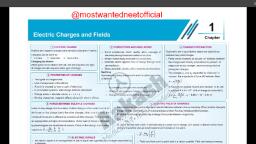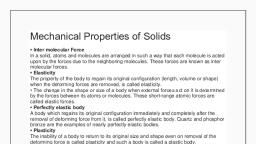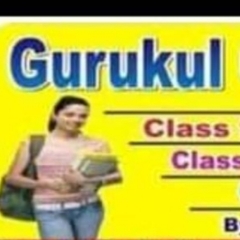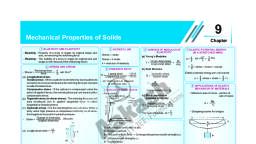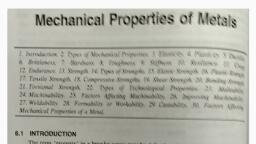Page 1 :
Chapter 9, , Mechanical Properties, of Solids, , Chapter Contents, , © Introduction Introduction, , ° Elastic Behaviour of Solids jn chapter 7, we studied the rotation of the bodies and then realised, , e Stress and Strain that the motion of a body depends on how mass is distributed within, oi Hodke’s' Tans the body. We restricted ourselves to simpler situation of rigid bodies., Rigid bodies don't bend, stretch, or squash when forces act on them., But the rigid body is an idealization. All real materials are elastic and, e Elastic Moduli do deform to some extent., , e Applications of Elastic, , e Stress-Strain Curve, , Elastic properties of material are tremendously important. You want, Behaviour of Materials, , the wings of an airplane to be able to bend a little, but you'd rather not, © Some Important Definitions have them break off. The steel frame of an earthquake resistant, e Formulae Chart building has to be able to flex, but not too much. Many of the necessities, © Quick R of every day life, from rubber bands to suspension bridges, depend on, the elastic properties of material., , In this chapter we will introduce the concepts of stress, strain and, elastic modulus and a simple principle called Hooke’s law that help us, predict what deformation will occur when forces are applied to a real, kind of (not perfect rigid) body., , ELASTIC BEHAVIOUR OF SOLIDS, , We know that in a solid, each atom or molecule is surrounded by, neighbouring atoms or molecules. These are bonded together by interatomic, or intramolecular forces and stay in a stable equilibrium position. When a, solid is deformed, the atoms or molecules are displaced from their equilibrium, positions causing a change in the interatomic (or intermolecular) distance., When the deforming force is removed, the interatomic forces tend to drive, them back to their original position. Thus the body regains its original shape, and size. The restoring mechanism can be visualised by taking a model of, , , , Aakash Educational Services Pvt. Ltd.-Regd. Office: Aakash Tower, 8, Pusa Road, New Delhi-110005 Ph.011-47623456
Page 2 :
7O Mechanical Properties of Solids Board & Competitive Exams., , spring-ball system shown in the figure. Here balls represent atoms and spring represents interatomic force., , , , Fig.: Spring-ball model for the illustration of elastic behaviour of solids., , If you try to displace any ball from its equilibrium position, the spring system tries to restore the ball back to, its original position. Thus elastic behaviour of solids can be explained in terms of microscopic nature of solid., , STRESS AND STRAIN, , The rigid body is a useful idealized model, but the stretching, squeezing and twisting of real bodies when, forces are applied are often too important to ignore. Figure shows three examples. We want to study the, relationship between the forces and deformation for each case., , For each kind of deformation we will introduce a quantity called stress that characterizes the strength of the, force causing the deformation, on a “force per unit area” basis. Another quantity, strain, describes the resulting, , deformation., L+AL &), u, (ay °F (b), , (c) (d), , Fig.: (a) Cylinder subjected to tensile stress stretches it by an amount AL. (b) A cylinder subjected to, shearing (tangential) stress deforms by an angle 0. (c) A book subjected to a shearing stress, (d) A solid sphere subjected to a uniform hydraulic stress shrinks in volume by an amount AV., , , , , , Tensile and Compressive Stress and Strain, , The simplest elastic behaviour to understand is the stretching of a bar, rod or wire when its ends are pulled., Figure shows an object that initially has uniform cross-sectional area A and length |,. We then apply forces, of equal magnitude F, but in opposite directions at the ends (this ensures that the object has no tendency, , Aakash Educational Services Pvt. Ltd.-Regd. Office: Aakash Tower, 8, Pusa Road, New Delhi-110005 Ph.011-47623456
Page 3 :
Board & Competitive Exams. Mechanical Properties of Solids 71, to move). We say that the object is in tension. The subscript 1 is a reminder that the forces act perpendicular, to the cross-section., , Initial state, of the object, , Object under, tensile stress, , , , k—/, , Fig.: An object in tension. The net force on the object is zero, but the object deforms. The, tensile stress (the ratio of the force to the cross-sectional area) produces a tensile strain, , (the elongation divided by the initial length)., We define the tensile stress at the cross-section as the ratio of the force F, to the cross-sectional area A :, , Tensile stress = a ---(i), , This is a scalar quantity because F, is the magnitude of the force. The SI unit of stress is the pascal., Equation (i) shows that 1 pascal equals 1 newton per square metre (N/m?) :, , , , The unit of stress is same as that of pressure. Air pressure in automobile tyres is typically around 300 kPa,, and steel cables are commonly required to withstand tensile stress of the order of 10° Pa., , The object shown in figure stretches to a length / = /, + AJ when under tension. The elongation A/ does not, occur only at the ends; every part of the bar stretches in the same proportion. The tensile strain of the object, is equal to the fractional change in length, which is the ratio of the elongation A/ to the original length /,., , , , , , , , , , , , , , , , , , I-k Al, Tensile strain = ——® = — ---Cli), fo 1, It is a ratio of two lengths, always measured in the same unit, and so is a pure (dimensionless) number with, no units., Initial state 4=— Area A, of the object, keh, AL, i, Object under F. a, Compressive, stress, fT he, , , , , , Fig.: An object in compression. The compressive stress and compressive strain are defined in, the same way as tensile stress and strain, except that A/ now denotes the length through, which the object contracts., , When the forces at the ends of a bar push rather than pull (figure), the bar is in compression and the stress, is compressive stress. The compressive stress of an object in compression is defined in the same way, as the tensile strain, but A/ has the opposite direction., , Aakash Educational Services Pvt. Ltd.-Regd. Office: Aakash Tower, 8, Pusa Road, New Delhi-110005 Ph.011-47623456
Page 4 :
72 = Mechanical Properties of Solids Board & Competitive Exams., , Example 1: A rod has a radius of 100 mm and a length of 10 cm. A 100 N force compresses along its length., Calculate the stress developed in the rod., , Solution : Given, r = 100 mm = 100 x 10° m, 1= 10cm = 10 x 107m, , , , F=100N, Stress = Free _ ae = 3184.71N/m?, area (100 x 10°)? mi, ———, Try Yourself, , 1. When a body is under certain stress, is it in equilibrium?, 2. What is the dimensional formula of tensile stress?, , , , , , ~—, , , , Knowledge Cloud, , In many situations, bodies can experience both tensile and compressive stresses at the same time. As an, example, a horizontal beam supported at each end sags under its own weight. As a result, the top of the, beam is under compression, while the bottom of the beam is under tension (fig. a). To minimize the stress, and hence the bending strain, the top and bottom of the beam are given a large cross-sectional area. There, is neither compression nor tension along the center line of the beam, so this part can have a small cross, section; this helps to keep the weight of the bar to a minimum and further helps to reduce the stress. The, result is an I-beam of the familiar shape used in building construction (fig. b)., The top and bottom of an I-beam are broad to, , Top of beam is Beam sconenne ae minimize the compressive and tensile stresses., , under compression. nor compression., The beam can be, narrow near its, centerline, which, y — Is neither under, compression nor, under 5, Bottom of beam is under tension saosin, , Fig.: (a) A beam supported at both ends is Fig.: (b) The cross-sectional shape of an I-beam, under compression as well astension. minimizes stress and weight., , , , , , , , , , , , Shear Stress and Strain, Figure shows a body being deformed by a shear stress. In the figure, forces of equal magnitude but opposite, direction act tangent to the surface of opposite ends of the object. We define the shear stress as the force, Fy acting tangent to the surface, divided by the area A on which it acts :, , Fi, Shear stress = - .-- (ili), , Aakash Educational Services Pvt. Ltd.-Regd. Office: Aakash Tower, 8, Pusa Road, New Delhi-110005 Ph.011-47623456
Page 5 :
Board & Competitive Exams. Mechanical Properties of Solids 73, , , , Initial state I, of the object 1, , , , , , , , Object under F, shear stress {1 |, , , , Fig.: An object under shear stress. Forces are applied tangent to opposite surfaces of the, object (in contrast to the situation, in which the forces act perpendicular to the surfaces)., The deformation x is exaggerated for clarity., , Figure shows that one face of the object under shear stress is displaced by a distance x relative to the, opposite face. We define shear strain as the ratio of the displacement x to the transverse dimension h., , Shear strain = In real-life situation, x is always much smaller than h. Like all strains, shear strain is a dimensionless number, as; it is a ratio of two lengths., Example 2: Suppose the object in figure shown is the brass plate of an outdoor sculpture. It experiences shear, forces as a result of an earthquake. The frame is 0.80 m and 0.50 cm thick. Calculate the shear, strain produced in this object if the displacement x is 0.16 mm. (Shear modulus = 3.5 = 10'° Pa), , , , , , , , Try Yourself, , 3. In previous example, calculate the stress produced in brass plate., Hint : Stress = (shear strain) x (shear modulus), , 4. In previous example, what is the magnitude of the shear force?, Hint : F, = (shear stress) x A, , , , , , , , Aakash Educational Services Pvt. Ltd.-Regd. Office: Aakash Tower, 8, Pusa Road, New Dethi-110005 Ph.011-47623456













